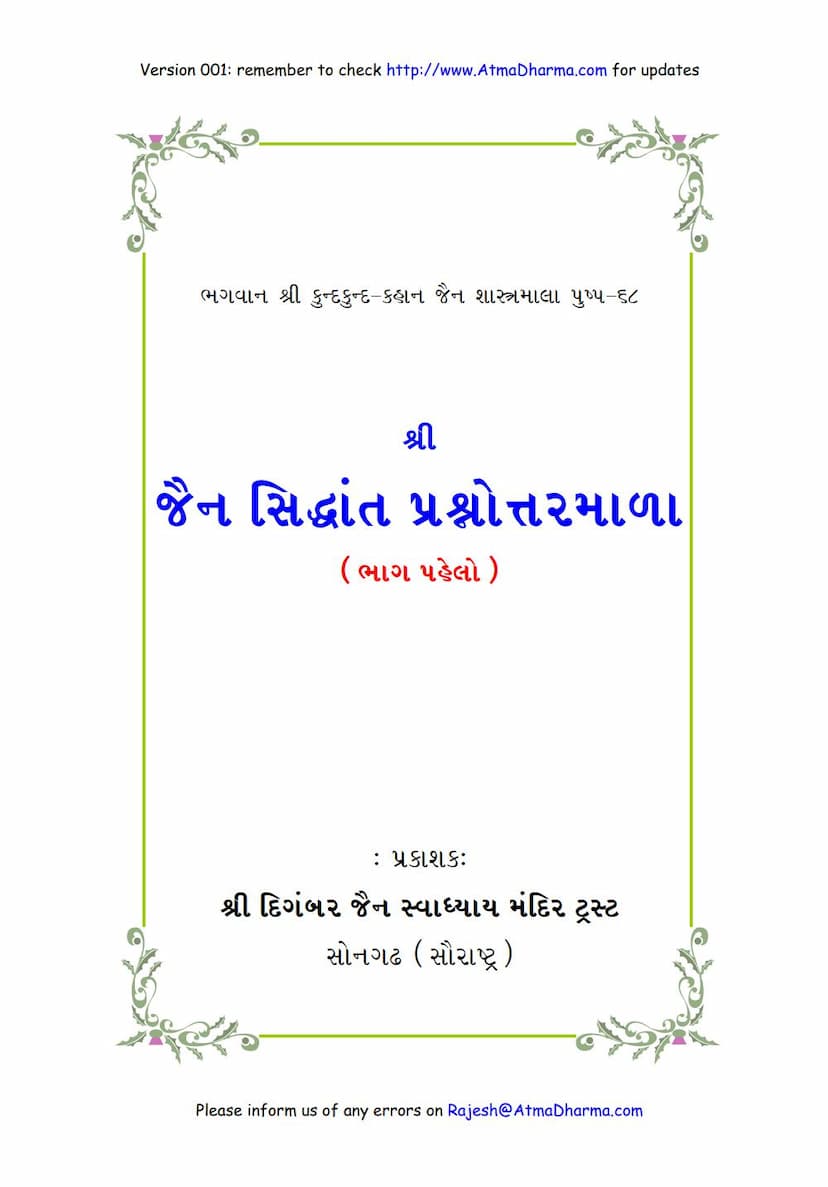Jain Siddhanta Prashnottarmala 1
Added to library: September 2, 2025

Summary
This Jain text, titled "Jain Siddhanta Prashnottarmala" (Book 1), published by the Digambar Jain Swadhyay Mandir Trust, Songadh, is a comprehensive question-and-answer compendium of fundamental Jain philosophical principles. It aims to make these core tenets accessible to everyone, from children to adults, by presenting them in a clear, interrogative format.
The book, compiled by the Digambar Jain Swadhyay Mandir Trust, Songadh, is a significant resource for understanding Jain philosophy. It was inspired by the teachings of Pujya Gurudev Shri Kanji Swamiji and Pujya Bhagati Bahenshri Champaben, who are credited with spreading the essence of spiritual knowledge.
Key Features and Content:
- Purpose: To clarify basic principles of Jain philosophy, such as the nature of reality, the path to liberation, and the interpretation of Jain scriptures, in a question-and-answer format for easy comprehension.
- Structure: The book is organized thematically, covering essential topics like:
- Dravya (Substance): Exploring the fundamental categories of existence.
- Guna (Attribute): Examining the inherent qualities of substances.
- Paryaya (Mode/Modification): Understanding the transient states of substances.
- Abhava (Non-existence/Absence): Discussing the concept of negation.
- Kartru-Karmaadi Six Causes: Analyzing the agents and factors involved in causality.
- Upadana-Nimitta and Nimitta-Naimittika: Delving into the relationship between material and instrumental causes.
- Methodology: The text emphasizes the importance of understanding scriptural meanings through the lens of Niyaya (logic) and Naya (viewpoints), particularly distinguishing between Nishchaya Naya (ultimate truth) and Vyavahara Naya (conventional truth). It stresses that all scriptural statements, whether seemingly contradictory, are reconcileable when viewed through the correct Naya.
- Core Philosophical Concepts Covered:
- Dravya, Guna, Paryaya: The fundamental ontological categories in Jainism.
- Abhava: The concept of non-existence or absence.
- Kartru-Karmaadi Six Karaka: The six logical causes (agent, object, instrument, recipient, source, and location) and their application in Jain philosophy, emphasizing the self-contained nature of substances.
- Upadana and Nimitta Karana: The crucial distinction between the intrinsic material cause (Upadana) and the extrinsic instrumental cause (Nimitta). The text strongly argues that while Nimitta may be present, it is the Upadana (the substance's inherent capacity) that is the true cause of any modification or event. It clarifies that Nimitta is merely an indicator or a coincidental presence, not an active participant in causing the event.
- Niyaya and Naya: The text elaborates on the necessity of understanding scriptural texts from different viewpoints (Naya) to grasp their true meaning, particularly the distinction between Nishchaya Naya (the ultimate, real perspective) and Vyavahara Naya (the conventional, practical perspective). It explains how apparent contradictions in scriptures are resolved through the proper application of these Nayās.
- Saptatattva and Navapadartha: The seven realities (soul, non-soul, influx, bondage, stoppage, eradication, and liberation) and the nine categories are foundational to Jain ontology and soteriology.
- Pramana, Naya, Nikshepa: These are the tools of valid knowledge and reasoning in Jainism, crucial for understanding reality.
- Anakanta and Syadvada: The principles of non-absolutism and conditional predication, central to Jain logic, are explained.
- Moksha Marga: The path to liberation is discussed, emphasizing the ultimate reliance on the soul's inherent nature and self-effort rather than external factors or instruments.
- Gunasthana: The fourteen stages of spiritual development are touched upon.
- Sarvajna: The nature and omniscience of the Jinas are elaborated upon.
- Emphasis: A significant portion of the text is dedicated to refuting misconceptions about causality, particularly the role of Nimitta (instrumental causes) in the Jain context. It strongly advocates for the principle that the Upadana (inherent nature of the substance) is the sole true cause of any modification or event, while Nimitta is merely an indicator or a concurrent condition without causal efficacy. This perspective is crucial for understanding Jain metaphysics and the emphasis on self-reliance in spiritual progress.
- Editions: The book has undergone multiple editions, indicating its popularity and importance in Jain religious education.
- Goal: The ultimate aim of the book is to guide individuals toward spiritual liberation (Moksha) by fostering a clear understanding of Jain principles and encouraging self-reflection and effort in realizing the soul's true nature.
In essence, "Jain Siddhanta Prashnottarmala (Bhag 1)" serves as a foundational text for understanding the core philosophical tenets of Jainism, presented in a Q&A format to facilitate learning and spiritual inquiry. It underscores the importance of self-effort and the soul's inherent capabilities in the path to liberation, while clarifying the precise role of instrumental causes and different logical viewpoints in interpreting Jain teachings.